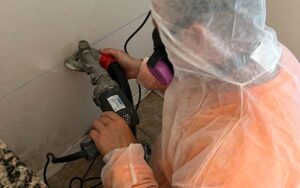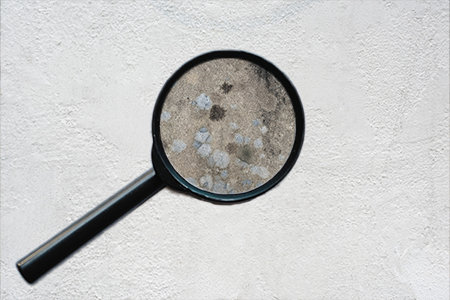Think you might have mold in your home? In the realm of homeownership, few concerns provoke as much dread as the mere mention of mold. The presence of mold in the home can instigate anxiety due to the potential health risks and structural damage it poses. However, amidst the horror stories and myths surrounding mold, this article seeks to provide clarity and empowerment. This comprehensive guide aims to demystify the topic. By exploring the subtle indicators and unmistakable signs of mold infestation, you’ll be equipped to take informed action for a healthier living environment.
Table of Contents
Understanding Mold: Origins and Impact
Before delving into the signs of mold in your home, it’s essential to understand the origins and impact of this elusive intruder. Mold, a type of fungus, is a natural part of our environment. It plays a vital role in breaking down organic matter and recycling nutrients. However, when mold infiltrates our indoor spaces, it can lead to a range of problems. Mold thrives in damp and humid environments, making bathrooms, kitchens, basements, and other moisture-prone areas susceptible. Not only can mold damage the structural integrity of your home, but it can also trigger allergic reactions, respiratory issues, and other health problems, especially for individuals with sensitivities.
Dispelling Common Myths About Mold in Your Home
Myth: Only Black Mold Is Dangerous
Black mold, specifically Stachybotrys chartarum, has garnered a notorious reputation for its potential health hazards. However, all mold types, regardless of color, have the potential to cause health problems under certain conditions. Color is not a definitive indicator of toxicity.
Myth: Mold Is Harmless if It’s Small
The size of a mold infestation does not necessarily correlate with its impact on health. Even a small amount of mold can release spores that trigger allergic reactions and other health issues.
Myth: Cleaning Mold with Bleach Solves the Problem
While bleach can temporarily remove visible mold, it does not address the root cause of the issue. Mold often grows deeper within porous materials, and using bleach can even exacerbate the problem by adding moisture to the area.
Myth: Mold Only Grows in Dirty Homes
Mold growth is not solely dependent on cleanliness. Even well-maintained homes can experience mold problems if they have high humidity, leaks, or poor ventilation.
What Types of Mold Are Common In Arizona Homes?
In the hot and dry climate of Phoenix, Arizona, mold growth tends to be less common compared to more humid regions. However, some molds can still thrive indoors, especially in areas where moisture is present. The following are a few mold types that might be more relevant to the Phoenix climate:
Aspergillus:
Aspergillus is adaptable and can grow in various environments, including drier conditions like those in Phoenix.
Penicillium:
Penicillium can be found in indoor environments with moderate humidity levels, which can be maintained even in a dry climate.
Cladosporium:
Cladosporium is known for tolerating a wide range of temperatures and humidity levels, making it possible to find it indoors even in drier climates.
Alternaria:
Alternaria can grow on damp surfaces and is commonly found in showers or areas prone to water exposure.
The 9 Signs Of Mold In Your Home
Visible Discoloration
Of the 9 signs you might have mold in your home, this one is usually the most obvious. Visible discoloration on walls, ceilings, or other surfaces can be an early indicator of a potential mold problem. The appearance of green, black, or brown patches suggests that moisture has provided a fertile ground for mold to thrive. These discolored spots might start small but can quickly spread if not addressed. It’s essential to investigate the source of the moisture, whether from leaks, poor ventilation, or humidity, and take action to prevent further growth.
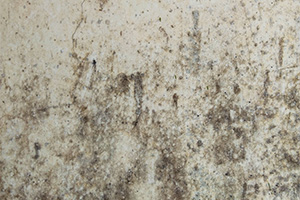
Water Stains
Water stains on walls, ceilings, or floors can be a red flag for mold in your home. While the stain itself might not be mold, the moisture it suggests can create an ideal environment for mold to flourish. It’s crucial to investigate the source of the moisture, repair any leaks, and ensure proper ventilation to prevent future staining and mold growth.
High Humidity
Persistently high indoor humidity levels can create an environment conducive to mold growth in your home. Humidity provides the moisture mold needs to thrive, and areas with inadequate ventilation can trap this moisture indoors. Monitoring humidity levels using a hygrometer is crucial, especially in moisture-prone rooms like bathrooms, kitchens, and basements.

Musty Odors
The scent of mold can make itself manifest before any visual signs appear. The scent of a musty library is a good description of mold smell. This peculiar odor, reminiscent of old books, warns of the stealthy presence of mold even when it’s shrouded from view. Smell can be used to detect mold that may be compromising the interior structure of your home.
Allergic Symptoms
Of the 9 signs you might have mold in your home, this one is most commonly discussed, and the least likely understood. If you or your family members experience frequent allergic symptoms such as coughing, sneezing, watery eyes, and congestion while indoors, it could be a sign of mold presence. Mold spores released into the air can trigger allergic reactions in sensitive individuals. These symptoms may become more pronounced in certain areas of your home or during specific times of the day. Seeking medical advice and addressing the mold issue can lead to improved indoor air quality and better respiratory health.
Skin Irritation
Unexplained skin rashes, hives, or itching could potentially be linked to mold exposure. Mold spores can come into contact with your skin, leading to various skin irritations. While skin issues might not be the most common sign of mold, they should not be ignored, especially if they coincide with other potential indicators. If you’re experiencing persistent skin problems that seem to worsen while at home, it’s worth investigating the possibility of mold growth. Here’s the CDC’s in depth research on mold and its health related risks.
Peeling Wallpaper or Paint
Peeling or bubbling wallpaper, paint, or other wall coverings can be a sign of moisture-related issues and potential mold in your home. Moisture can seep through walls and compromise the adhesive properties of these materials, causing them to lose adhesion and peel away. This type of damage is often a result of water infiltration from leaks or high humidity levels. Properly investigating and repairing the underlying moisture issue is crucial to preventing further damage and potential mold infestation

Warped or Bulging Walls
Walls that appear warped, bulging, or distorted can signal a significant moisture problem and the possibility of mold in your home. Water intrusion from leaks or excessive humidity can cause structural materials like drywall to swell and deform. These visible changes in the walls’ appearance are often accompanied by other signs of water damage, such as stains and a musty smell. Ignoring such changes can lead to more extensive mold growth and compromise the integrity of your home. Addressing the underlying moisture issue promptly, conducting thorough inspections, and considering professional help for remediation are essential steps to prevent further damage and mold-related health risks.
Rotting Wood
The presence of rotting or deteriorating wood in your home can be indicative of long-term moisture exposure and potential mold growth in the home. Wood, which serves as an organic food source for mold, can become weakened and compromised when exposed to excess moisture. Signs of rot include soft, crumbly, or discolored wood, often accompanied by a musty odor. It’s important to identify and address the source of moisture, whether it’s from leaks, poor ventilation, or high humidity levels. Taking proactive measures to repair or replace rotting wood and implementing preventive strategies can help mitigate mold growth and maintain the structural integrity of your home.
Common Mold Growth Areas
Moisture-Prone Areas
Bathrooms and kitchens, areas where water is commonly used, provide the perfect conditions for mold to flourish. Basements and crawl spaces, the dark underbelly of our homes, harbor the dark, dampness that molds crave, and are thus prone to infection.
Poorly Ventilated Areas
Stagnant air is the veil that shrouds mold growth. Inadequate ventilation transforms closed spaces into mold’s sanctuary. Improved air flow, achieved through fans or windows, can help remediate mold.
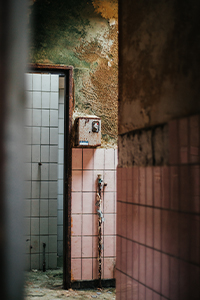
Water Leaks
Leaky roofs and plumbing problems can create dripping water that invites mold. Regular inspections and maintenance can help catch water problems before they become mold problems. Water leaks are the most common causes of mold in your home.
Seeking Professional Help
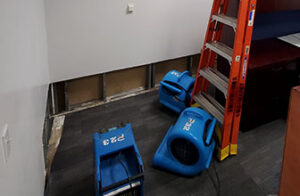
1. Mold Inspection and Assessment
Professionals begin by conducting a thorough mold inspection. This involves visually examining your home for visible signs of mold growth, such as discoloration, water damage, and peeling materials. They might also use specialized equipment like moisture meters and thermal imaging cameras to detect hidden moisture pockets where mold could be thriving.
During the assessment, professionals will identify the type of mold present. This information is crucial in determining the appropriate treatment plan and understanding the potential health risks associated with the specific mold species.
2. Air and Surface Sampling
In some cases, professionals might perform air and surface sampling to assess mold spore levels and identify potential sources of contamination. Air samples are collected using air pumps that pull air through a collection device, capturing mold spores. Surface samples involve swabbing or tape-lifting areas suspected of harboring mold. These samples are sent to a laboratory for analysis, which helps confirm the presence of mold and its concentration.
3. Developing a Remediation Plan
Once the extent of mold growth is determined, professionals develop a tailored remediation plan. This plan outlines the steps required to safely remove the mold and prevent its recurrence. The plan takes into account factors such as the type of mold, the affected areas, the source of moisture, and the potential health risks to occupants.
4. Containment and Removal
During the mold removal process, professionals take precautions to prevent the spread of mold spores to unaffected areas. This often involves creating containment barriers using plastic sheeting and employing negative air pressure systems to direct airborne mold particles outside. Personal protective equipment (PPE) is worn by workers to minimize their exposure to mold.
The physical removal of mold involves cleaning affected surfaces using specialized cleaning agents and techniques. Porous materials like drywall or insulation that are extensively contaminated might need to be removed and replaced to ensure complete removal of the mold.
5. Source of Moisture Elimination
Effective mold remediation goes beyond just removing visible mold. Professionals also focus on addressing the underlying source of moisture that allowed mold to flourish. This could involve repairing leaks, improving ventilation, or addressing humidity issues. Without eliminating the source of moisture, mold is likely to return.
6. Post-Remediation Verification
After completing the mold removal process, professionals conduct a final assessment to ensure that all mold has been successfully removed. This might involve additional air or surface sampling to confirm that mold spore levels are within acceptable limits. Post-remediation verification provides assurance that the mold issue has been effectively resolved.
7. Preventive Recommendations
Professionals often provide recommendations to prevent future mold growth. This could include advising homeowners on proper ventilation, maintenance practices, and ways to manage indoor humidity levels.
Don't Let Mold Get You Down!
